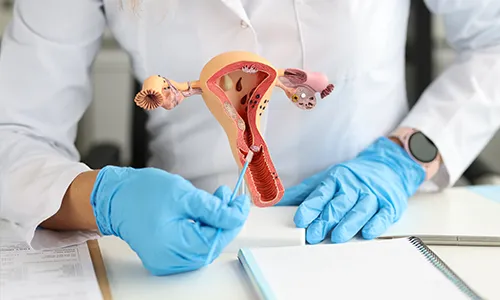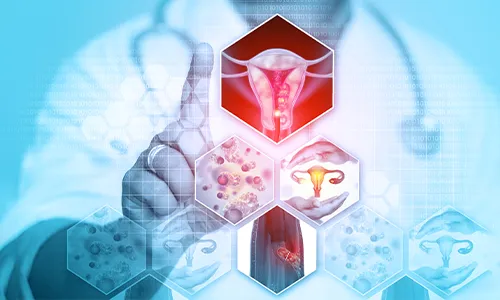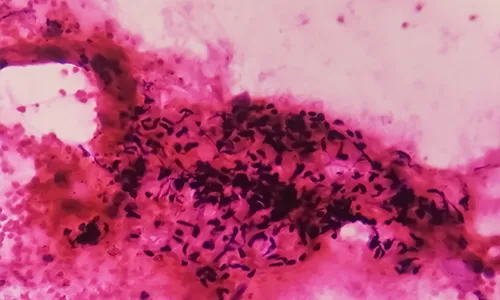

About Endometrial cancer
The endometrium is the term used for the uterus lining. One type of cancer that starts in the uterus is endometrial cancer.


Risk Factors & Prevention
Endometrial cancer is not necessarily caused by certain factors, even though they can enhance a woman’s risk for the disease.
Endometrial cancer risk is influenced by a variety of factors, including:
- Obesity
- Type 2 diabetes
- Family history of endometrial or colorectal cancer
- Having previously battled ovarian or breast cancer
- Having previously experienced endometrial hyperplasia
- Radiation therapy to the pelvis for the treatment of a different malignancy
How can it be prevented?
- Maintain a healthy weight
- Get treatment for hereditary nonpolyposis colon cancer
- Get help for endometrial issues
- Be physically active


Screening
All women should be informed of the dangers and signs of endometrial cancer at menopause. They should be strongly encouraged to notify their doctor of any vaginal bleeding, discharge, or spotting. Women should also discuss routine pelvic checks with their doctors.


Symptoms & Signs
- Unexpected vaginal bleeding / Post-menopausal vaginal bleeding
- An unusual vaginal discharge/ Spotting
- Pelvic pain
- Weight loss


Diagnosis
Endometrial cancer diagnostic tests determine whether you have the disease and how aggressive it may be.
Tools and tests include:
- Complete physical exam and pelvic exam
- Ultrasound
- Endometrial Biopsy
- Hysteroscopy
- Cystoscopy
- Proctoscopy
- Chest x-ray
- MRI
- CT scan
- PET scan


Sub-Types and Stages
- Endometrioid
- Uterine carcinosarcoma or CS
- Clear cell carcinoma
- Serous carcinoma
- Squamous cell carcinoma
- Small cell carcinoma
- Dedifferentiated Carcinoma
Stages
Stage 1:
Cancer is exclusively found in the uterus
Stage 2:
Cancer has entered the cervix’s connective tissue but has not yet left the uterus.
Stage 3:
Cancer spreads past the uterus and cervix but not the pelvis.
Stage 4:
Cancer has progressed beyond the pelvis to the other body parts.


Treatment Modalities
a. Surgical Oncology
The primary method of treatment for endometrial cancer is typically surgery, which includes:
- Hysterectomy- To remove the cervix and uterus.
- Salpingo-oophorectomy- The removal of the ovaries and fallopian tubes.
- Removal of lymph nodes- Removing the lymph nodes around the aorta and pelvis.
b. Medical Oncology
- Chemotherapy-Chemotherapy is usually given after surgery in early stages. It’s also the recommended treatment for advanced cases.
- Hormone therapy- If endometrial cancer has spread outside the uterus and is advanced, hormone therapy may be possible if the patient is not fit for any other therapy. It entails using medicine to reduce the body’s hormone levels.
- Targeted Therapy- For the treatment of advanced endometrial cancer, targeted medication therapy is frequently used in conjunction with immunotherapy.
- Immunotherapy- A medicinal therapy called immunotherapy supports the immune system’s ability to fight cancer. If the cancer is advanced, immunotherapy is recommended.
c. Radiation Oncology
- Radiation therapy employs powerful energy beams like protons and X-rays to kill cancer cells. Radiation from a machine outside of your body or radiation implanted inside of your body can both be used in radiation therapy.


Coping with Treatment
Along with the medical side effects of endometrial cancer therapy, patients also deal with the financial burden of cancer care and the emotional and social impacts. Talking to a counselor or family member can help them to cope with treatment. MOC provides facility of psycho Onco-Counseling and Nutritional counseling to help patients.


Do’s & Don’ts During Treatment
Do’s
- Maintain a Healthy Weight
- Exercise regularly
- Follow a plant-based diet
Don’ts
- Avoid dairy products or saturated fats
- Don’t miss follow-up visits


Post-Treatment Support
Post-treatment endometrial cancer survivors can go through the long-term side effects of surgery, radiation therapy, chemotherapy, and hormonal therapy. They can also have symptoms such as Nausea and vomiting, Loss of appetite, Mouth sores, vaginal sores, and Hair loss. Survivors require empathy, mental strength, and support from their families, and they can also join endometrial cancer Post-Treatment Survivorship Support Groups.


Follow-ups Cancer Care Plan
Post-treatment, one must request a follow-up treatment plan. Doctors provide a personalized treatment plan based on the type and stage of cancer.


Surveillance and monitoring for Signs & Symptoms of Recurrence
One aim of follow-up care is checking for a recurrence. One should never miss follow-up visits and never ignore any symptoms of recurrence. Because some cancer cells may remain undiscovered in the body in small locations that don’t respond to treatment, cancer can reoccur. A physician knowledgeable about your medical history can provide personalized information regarding your risk of recurrence during follow-up care.


FAQ’s
-
Endometrial cancer: what is it?
Cancer arising from the lining of the uterus or endometrium.
-
What are the methods of detecting endometrial cancer?
There are no screening tests for women with no symptoms to find endometrial cancer. If you are postmenopausal, you should have any unusual bleeding examined.
-
What signs indicate endometrial cancer?
Unusual vaginal bleeding is the sign of endometrial cancer that occurs most frequently. This includes spotting, irregular menstrual flow, and bleeding in between periods for premenopausal women.
Specialized Doctors at M | O | C
Find the nearest center
Cancer Centres
Mumbai
Pune
Rest of Maharashtra
Gujarat
Delhi NCR
Cancer Clinics
Borivali
+91 9920767626
Book Your Appointment



























.png)









.png)




















.png)



